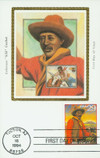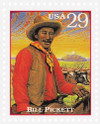
# 2869g - 1994 29c Legends of the West: Bill Pickett
U.S. #2869g
1994 29¢ Bill Pickett
Legends of the West
- From the corrected version of the famed Legends of the West error sheet
- First sheet in the Classic Collection Series
Stamp Category: Commemorative
Set: Legends of the West
Value: 29¢, rate for first-class mail
First Day of Issue: October 18, 1994
First Day Cities: Tucson, Arizona; Lawton, Oklahoma; Laramie, Wyoming
Quantity Issued: 19,282,800
Printed by: Stamp Venturers
Printing Method: Photogravure
Format: Panes of 20 in sheets of 120
Perforations: 10.2 x 10.1
Why the stamp was issued: The Legends of the West sheet was the first issue in the Classic Collection Series. It was developed from an idea to honor “Western Americana.”
About the stamp design: Stamp artist Mark Hess spent nearly two years working on the Legends of the West stamps. The corrected Bill Pickett stamp was largely based on a movie poster for the 1923 film The Bull-Dogger. The original error stamp featured a portrait of Bill’s brother Ben, which had been erroneously cited to be of Bill for many years and in many books and other publications.
Special design details: This stamp comes from the famed Legends of the West sheet, which made headlines due to two mistakes made by the United States Postal Service and led to a string of events without precedent in the history of US stamp collecting.
One of the people to be featured on the sheet was black rodeo star Bill Pickett. After the stamps were announced, but not officially issued, a radio reporter phoned Frank Phillips Jr., great-grandson of Bill Pickett, and asked him about the stamp. Phillips went to his local post office, looked at the design and recognized it as Ben Pickett – Bill’s brother and business associate. The stamp pictured the wrong man! That was the first mistake.
Phillips complained to the Postal Service and Postmaster General Marvin Runyon issued an order to recall and destroy the error stamps. Runyon also ordered new revised stamps be created – these are the corrected Legends of the West stamps – #2869.
But before the recall, 186 error sheets were sold by postal workers – before the official “first day of issue.” This was the second mistake. These error sheets were being resold for sums ranging from $3,000 to $15,000 each!
Several weeks later the US Postal Service announced that 150,000 error sheets would be sold at face value by means of a mail order lottery. This unprecedented move was made with the permission of Frank Phillips Jr. so the Post Office could recover its printing cost and not lose money. Sales were limited to one per household. The remaining stamps were destroyed.
About the printing process: In order to include the text on the back of the Legends of the West stamps, it had to be printed under the gum, so that it would still be visible if a stamp was soaked off an envelope. Because people would need to lick the stamps, the ink had to be approved by the Food and Drug Administration as non-toxic. The printer also used an extra-fine 300-line screen, which resulted in some of the highest-quality gravure stamp printings in recent years.
First Day Cities: The Laramie, Wyoming First Day ceremony was held at the University of Wyoming. The Tucson, Arizona ceremony was held at the Old Tucson Studios, where the High Chaparral TV series and several Western movies had been filmed. The Lawton, Oklahoma ceremony was held at Fort Sill, where Geronimo was buried.
About the Legends of the West: The Legends of the West sheet was ultimately born out of a discussion to issue a stamp to honor the 100th anniversary of Ellis Island in 1992. That plan was abandoned, but was Ellis Island was featured on a postal card in the Historic Preservation Series (#UX165). Talks then pivoted to a stamp honoring “Western Americana.” Stamp artist Mark Hess was tasked with producing four semi-jumbo stamp images capturing the colorful and graphic look of old Wild West show posters. The Citizens Stamp Advisory Committee (CSAC) discussed Hess’ images and decided to expand on the idea and honor 16 significant men and women that played major roles in the expansion of the West. At one point, they considered outlaws such as Butch Cassidy, Billy the Kid, and Jesse James, but ultimately decided to “come down on the side of right and justice.” The sheet of 20 had a decorative header and descriptive text was included on the back of each stamp.
The Legends of the West stamp designs were also adapted to postal cards, #UX178-97.
History the stamp represents:
Born in south Texas, Bill Pickett was one of the 5,000 early black cowboys to work on the western ranches. It was during his days as a cowhand that he developed the technique of “bulldogging” – a trademark for which he became internationally famous. Galloping alongside a steer, he would seize the animal by its horns and twist its head up until he could sink his teeth into its upper lip, causing the beast to drop to the ground in pain.
In 1905, Pickett signed on with the Miller 101 Ranch, an Oklahoma spread that prided itself on its skillful cowhands. Within two short years, the ranch was staging elaborate rodeos. A prime attraction, Pickett wrestled steers, while Will Rogers performed tricks with his lariat and Tom Mix dazzled the crowds with his horsemanship.
The show toured the nation and eventually reached Madison Square Garden where it took New York City by storm. In Mexico City it was wagered that Pickett could hold onto a fighting bull for five minutes. Expecting to see Pickett killed, Mexicans thronged to the arena. Miraculously he held on, and after six minutes the crowd conceded Pickett had won. In 1971, he became the first black cowboy to have his memory enshrined in the National Rodeo Hall of Fame.
U.S. #2869g
1994 29¢ Bill Pickett
Legends of the West
- From the corrected version of the famed Legends of the West error sheet
- First sheet in the Classic Collection Series
Stamp Category: Commemorative
Set: Legends of the West
Value: 29¢, rate for first-class mail
First Day of Issue: October 18, 1994
First Day Cities: Tucson, Arizona; Lawton, Oklahoma; Laramie, Wyoming
Quantity Issued: 19,282,800
Printed by: Stamp Venturers
Printing Method: Photogravure
Format: Panes of 20 in sheets of 120
Perforations: 10.2 x 10.1
Why the stamp was issued: The Legends of the West sheet was the first issue in the Classic Collection Series. It was developed from an idea to honor “Western Americana.”
About the stamp design: Stamp artist Mark Hess spent nearly two years working on the Legends of the West stamps. The corrected Bill Pickett stamp was largely based on a movie poster for the 1923 film The Bull-Dogger. The original error stamp featured a portrait of Bill’s brother Ben, which had been erroneously cited to be of Bill for many years and in many books and other publications.
Special design details: This stamp comes from the famed Legends of the West sheet, which made headlines due to two mistakes made by the United States Postal Service and led to a string of events without precedent in the history of US stamp collecting.
One of the people to be featured on the sheet was black rodeo star Bill Pickett. After the stamps were announced, but not officially issued, a radio reporter phoned Frank Phillips Jr., great-grandson of Bill Pickett, and asked him about the stamp. Phillips went to his local post office, looked at the design and recognized it as Ben Pickett – Bill’s brother and business associate. The stamp pictured the wrong man! That was the first mistake.
Phillips complained to the Postal Service and Postmaster General Marvin Runyon issued an order to recall and destroy the error stamps. Runyon also ordered new revised stamps be created – these are the corrected Legends of the West stamps – #2869.
But before the recall, 186 error sheets were sold by postal workers – before the official “first day of issue.” This was the second mistake. These error sheets were being resold for sums ranging from $3,000 to $15,000 each!
Several weeks later the US Postal Service announced that 150,000 error sheets would be sold at face value by means of a mail order lottery. This unprecedented move was made with the permission of Frank Phillips Jr. so the Post Office could recover its printing cost and not lose money. Sales were limited to one per household. The remaining stamps were destroyed.
About the printing process: In order to include the text on the back of the Legends of the West stamps, it had to be printed under the gum, so that it would still be visible if a stamp was soaked off an envelope. Because people would need to lick the stamps, the ink had to be approved by the Food and Drug Administration as non-toxic. The printer also used an extra-fine 300-line screen, which resulted in some of the highest-quality gravure stamp printings in recent years.
First Day Cities: The Laramie, Wyoming First Day ceremony was held at the University of Wyoming. The Tucson, Arizona ceremony was held at the Old Tucson Studios, where the High Chaparral TV series and several Western movies had been filmed. The Lawton, Oklahoma ceremony was held at Fort Sill, where Geronimo was buried.
About the Legends of the West: The Legends of the West sheet was ultimately born out of a discussion to issue a stamp to honor the 100th anniversary of Ellis Island in 1992. That plan was abandoned, but was Ellis Island was featured on a postal card in the Historic Preservation Series (#UX165). Talks then pivoted to a stamp honoring “Western Americana.” Stamp artist Mark Hess was tasked with producing four semi-jumbo stamp images capturing the colorful and graphic look of old Wild West show posters. The Citizens Stamp Advisory Committee (CSAC) discussed Hess’ images and decided to expand on the idea and honor 16 significant men and women that played major roles in the expansion of the West. At one point, they considered outlaws such as Butch Cassidy, Billy the Kid, and Jesse James, but ultimately decided to “come down on the side of right and justice.” The sheet of 20 had a decorative header and descriptive text was included on the back of each stamp.
The Legends of the West stamp designs were also adapted to postal cards, #UX178-97.
History the stamp represents:
Born in south Texas, Bill Pickett was one of the 5,000 early black cowboys to work on the western ranches. It was during his days as a cowhand that he developed the technique of “bulldogging” – a trademark for which he became internationally famous. Galloping alongside a steer, he would seize the animal by its horns and twist its head up until he could sink his teeth into its upper lip, causing the beast to drop to the ground in pain.
In 1905, Pickett signed on with the Miller 101 Ranch, an Oklahoma spread that prided itself on its skillful cowhands. Within two short years, the ranch was staging elaborate rodeos. A prime attraction, Pickett wrestled steers, while Will Rogers performed tricks with his lariat and Tom Mix dazzled the crowds with his horsemanship.
The show toured the nation and eventually reached Madison Square Garden where it took New York City by storm. In Mexico City it was wagered that Pickett could hold onto a fighting bull for five minutes. Expecting to see Pickett killed, Mexicans thronged to the arena. Miraculously he held on, and after six minutes the crowd conceded Pickett had won. In 1971, he became the first black cowboy to have his memory enshrined in the National Rodeo Hall of Fame.











